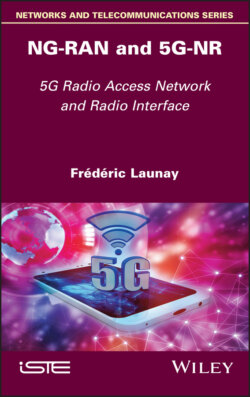Читать книгу NG-RAN and 5G-NR - Frédéric Launay - Страница 16
1.2.1. The NG-RAN
ОглавлениеThe NG-RAN provides both an LTE radio interface and a 5G-NR radio interface.
An NG-RAN node is:
1 – a 5G base station (gNB), which provides the control plane services and the transmission of user plane data through the 5G-NR radio interface;
2 – an advanced 4G base station (ng-eNB), providing control plane services and data transmission from the user plane to mobiles via the LTE radio interface.
The NG-RAN node is responsible for managing radio resources, controlling the radio bearer establishment of the user plane and managing mobility during the session (handover). The mobile connects to one of the radio nodes.
The NG-RAN node transfers the traffic data from the mobile to the UPF and data from the UPF to the mobile.
When the NG-RAN node receives data from the mobile or from the UPF, it refers to the QFI (QoS Flow Identifier) for the implementation of the data scheduling mechanism.
For outgoing data to the UPF entity, the NG-RAN node performs the marking of the DSCP (DiffServ Code Point) field of the IP (Internet Protocol) header, based on the assigned QFI.
The NG-RAN node performs compression and encryption of traffic data on the radio interface. It can also optionally perform the integrity control of the traffic data exchanged with the mobile.
The NG-RAN node performs the encryption and integrity control of the signaling data exchanged with the mobile on the radio interface.
The NG-RAN node performs the selection of the AMF. The AMF is the function of the core network to which the mobile UE is attached.
The NG-RAN broadcasts the RRC paging received from the AMF.
The NG-RAN node also broadcasts the cell’s system information, containing the radio interface characteristics. The devices use these parameters for cell selection and for radio bearer establishment requests.
When a mobile is connected, the NG-RAN uses the measurements made by the mobile to decide on the initiation of a cell change during a session (handover).
In order to manage the services for each connected mobile, the NG-RAN node maintains a UE context information block relating to each mobile. The information saved by the radio node may depend on the mobile usage.
The mobile is either in the RRC connected state (RRC_CONNECTED), the RRC inactive state (RRC_INACTIVE) or the standby RRC state (RRC_IDLE).
When the mobile enters the standby state, the base station is not aware of its presence. Each mobile in the standby state listens to the information broadcasts by the radio node.
There is no UE context at the radio node for the mobile in the RRC_IDLE state.
When the mobile enters the RRC_CONNECTED state or the RRC_INACTIVE state, a mobile radio identifier C-RNTI or I-RNTI, respectively, (Connected/Inactive Radio Network Temporary Identifier) is saved at the radio node. The context of the UE is saved in relation to the RNTI. The context is recorded at the level of the NG-RAN node, which manages the mobile (source node), and it is transmitted to the target node in the event of a handover. The UE context is also created at the level of the MN and at the level of the SN in the event of dual connectivity.
When a mobile is in the connected mode, the NG-RAN node uses measurements made by the mobile to decide whether to trigger a change of node during the session (handover) or to activate or deactivate secondary cells.
